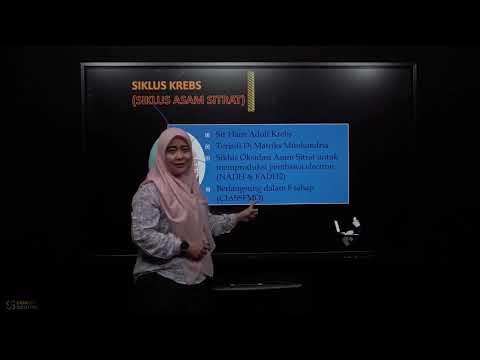Bagaimanakah tahapan Siklus Krebs atau Siklus Asam Sitrat?
Summary
TLDRThis video script delves into the Krebs cycle, the third stage of aerobic respiration following the oxidative decarboxylation process. Named after its discoverer, Hans Krebs, the cycle occurs in the mitochondrial matrix and consists of eight steps. It involves the conversion of acetyl-CoA into citrate, isocitrate, and other intermediates, ultimately producing CO2, NADH, FADH2, and ATP. The script also highlights the enzymes involved at each stage and ends with a promotion for a learning scholarship from SekolahMu, urging viewers to subscribe and follow for educational benefits.
Takeaways
- 🌟 The script discusses the Krebs cycle, also known as the citric acid cycle, which is the third stage of aerobic respiration following the oxidative decarboxylation process.
- 🔍 The Krebs cycle is named in honor of Hans Krebs, a German scientist who discovered this metabolic pathway.
- 📍 The cycle occurs in the mitochondrial matrix and involves the conversion of acetyl-CoA into various intermediate compounds, resulting in the production of energy.
- 🔬 The cycle begins with the condensation of acetyl-CoA with oxaloacetate to form citrate, releasing CoA in the process.
- ♻️ Citrate undergoes isomerization to isocitrate, involving the release and addition of water molecules, catalyzed by the enzyme aconitase.
- 🔋 Isocitrate is then converted to alpha-ketoglutarate, releasing electrons that reduce NADP+ to NADPH.
- 🔄 Alpha-ketoglutarate is further oxidized to succinyl-CoA, with the release of one carbon as CO2 and the formation of NADH.
- 🚀 Succinyl-CoA is converted to succinate, involving the synthesis of ATP through substrate-level phosphorylation.
- 🌀 Succinate is oxidized to fumarate, capturing electrons that form FADH2.
- 🔄 Fumarate is then hydrated to malate, which is oxidized back to oxaloacetate, completing the cycle and generating additional NADH.
- 🔑 The cycle produces three NADH, one FADH2, and one ATP per turn, with the oxidative decarboxylation process contributing additional NADH and FADH2 for the electron transport chain.
Q & A
What is the Krebs cycle, and why is it also known as the citric acid cycle?
-The Krebs cycle, also known as the citric acid cycle, is the third stage in the aerobic respiration process. It is named in honor of Hans Krebs, a German scientist who discovered the cycle. It is also called the citric acid cycle because citric acid is the first compound formed in the cycle.
Where does the Krebs cycle take place within a cell?
-The Krebs cycle takes place in the matrix of the mitochondria.
What is the first compound formed in the Krebs cycle, and what is its role?
-The first compound formed in the Krebs cycle is citrate, which is a six-carbon compound resulting from the condensation of acetyl-CoA with oxaloacetate. Citrate is crucial as it initiates the cycle.
What happens during the conversion of citrate to isocitrate in the Krebs cycle?
-During the conversion of citrate to isocitrate, a water molecule is removed in a dehydration reaction, and another water molecule is added in a hydration reaction, catalyzed by the enzyme aconitase.
What is the role of isocitrate dehydrogenase in the Krebs cycle?
-Isocitrate dehydrogenase catalyzes the conversion of isocitrate to alpha-ketoglutarate, releasing one carbon atom as CO2 and reducing NAD+ to NADH.
How does the Krebs cycle contribute to the production of ATP?
-The Krebs cycle contributes to ATP production by generating high-energy electron carriers (NADH and FADH2) and directly producing one molecule of ATP through substrate-level phosphorylation.
What is the significance of the reduction of NADP+ to NADPH during the Krebs cycle?
-The reduction of NADP+ to NADPH is significant as it provides a means for cells to store high-energy electrons that can be used in biosynthetic pathways, such as fatty acid synthesis.
What is the role of succinyl-CoA synthase in the Krebs cycle?
-Succinyl-CoA synthase catalyzes the conversion of succinyl-CoA to succinate, and in the process, it helps generate one molecule of ATP through substrate-level phosphorylation.
How does the conversion of malate to oxaloacetate in the Krebs cycle contribute to the cycle's continuation?
-The conversion of malate to oxaloacetate by malate dehydrogenase regenerates the starting compound of the cycle, oxaloacetate, allowing the cycle to continue and maintain the flow of metabolites.
What are the total number of NADH, FADH2, and ATP molecules produced per turn of the Krebs cycle?
-Each turn of the Krebs cycle produces three molecules of NADH, one molecule of FADH2, and one molecule of ATP.
How does the Krebs cycle relate to the oxidative decarboxylation process discussed in the previous video?
-The Krebs cycle follows the oxidative decarboxylation process, where the two acetyl-CoA molecules produced from pyruvate are used to start the Krebs cycle, linking glycolysis and the citric acid cycle.
Outlines

Этот раздел доступен только подписчикам платных тарифов. Пожалуйста, перейдите на платный тариф для доступа.
Перейти на платный тарифMindmap

Этот раздел доступен только подписчикам платных тарифов. Пожалуйста, перейдите на платный тариф для доступа.
Перейти на платный тарифKeywords

Этот раздел доступен только подписчикам платных тарифов. Пожалуйста, перейдите на платный тариф для доступа.
Перейти на платный тарифHighlights

Этот раздел доступен только подписчикам платных тарифов. Пожалуйста, перейдите на платный тариф для доступа.
Перейти на платный тарифTranscripts

Этот раздел доступен только подписчикам платных тарифов. Пожалуйста, перейдите на платный тариф для доступа.
Перейти на платный тариф5.0 / 5 (0 votes)






